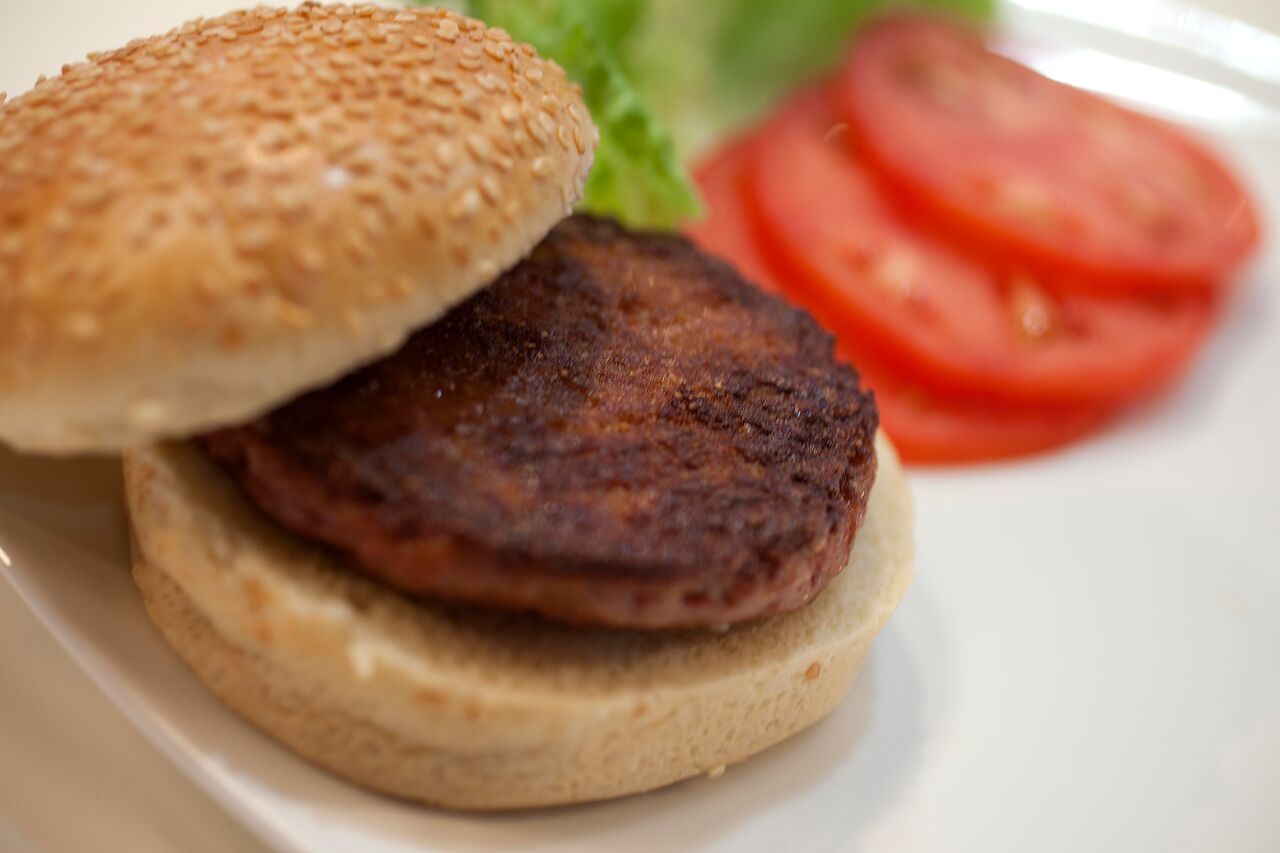
The first hamburger made entirely from cell cultured beef, made up of 20,000 muscle strands grown individually in Dr. Mark Post’s laboratory at Maastricht University. Photo by David Parry/PA WireThe first cell cultured beef hamburger was an important milestone in cellular agriculture. It showed the world that creating cultured meat was scientifically possible – and that from here onwards, the most important innovations in culturing meat will be how to produce it in large quantities for a reasonable price. In other words, thanks to the cultured beef burger, we know producing cultured meat is not a question of scientific discovery – it’s an engineering problem.
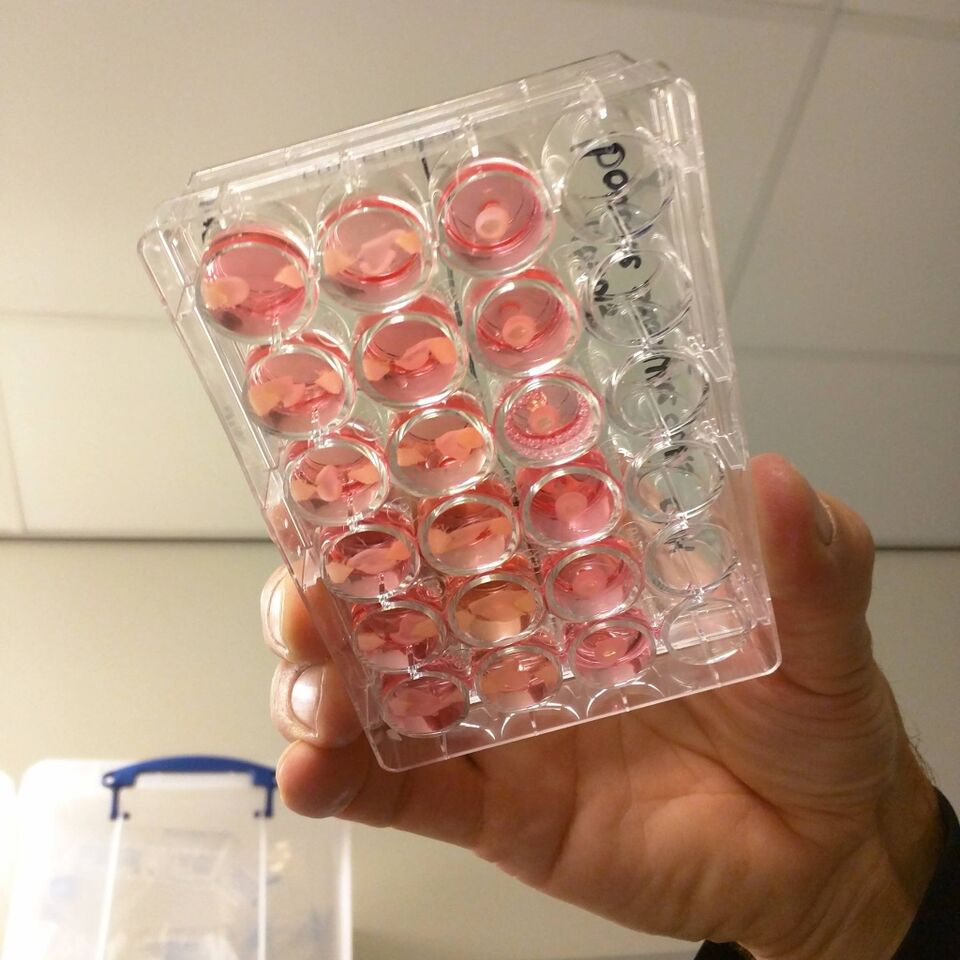
This image from Mark Post’s lab shows how muscle tissue is routinely grown in culture at laboratory scale. The cultured beef burger was created by growing muscle strands at this scale thousands of times.
The Story
The first government funded research on cultured meat took place in the Netherlands.
The Dutch government agency SenterNovem funded cultured meat research from 2005 to 2009, in part because of conversations between New Harvest founder Jason Matheny and the Dutch Minister of Agriculture in October of 2004.
The research program was initiated by Willem Van Eelen, an 86-year-old entrepreneur who had been fascinated by cultured meat for decades and had filed a patent on the idea in 1997. Dr. Henk Haagsman, of Utrecht University, was the principal grant writer for the Dutch cultured meat project. The project was subdivided into 3 different areas: a) stem cell biology, conducted at Utrecht University by Dr. Henk Haagsman and Dr. Bernard Roelen; b) tissue engineering, conducted at Eindhoven Technical University by Dr. Carlijn Bouten; and c) culture media, conducted at the University of Amsterdam by Dr. Klaas Hellingwerf. Included in the grant application were Meester Stegeman BV (at that time part of Sara Lee foods, Peter Verstrate) and Vitro Meat BV (Willem van Eelen). During this time, New Harvest contributed $7000 to Henk Haagsman’s lab.
In 2008, part way through the project, Dr. Carlijn Bouten had to pass on her project responsibilities. Dr. Mark Post was a part-time professor at Eindhoven Technical University at the time, and took the reins of the tissue engineering part of the project by supervising Dr. Bouten’s PhD students. Motivated by the potential impact of cultured meat, Mark continued research even after the grant ended.
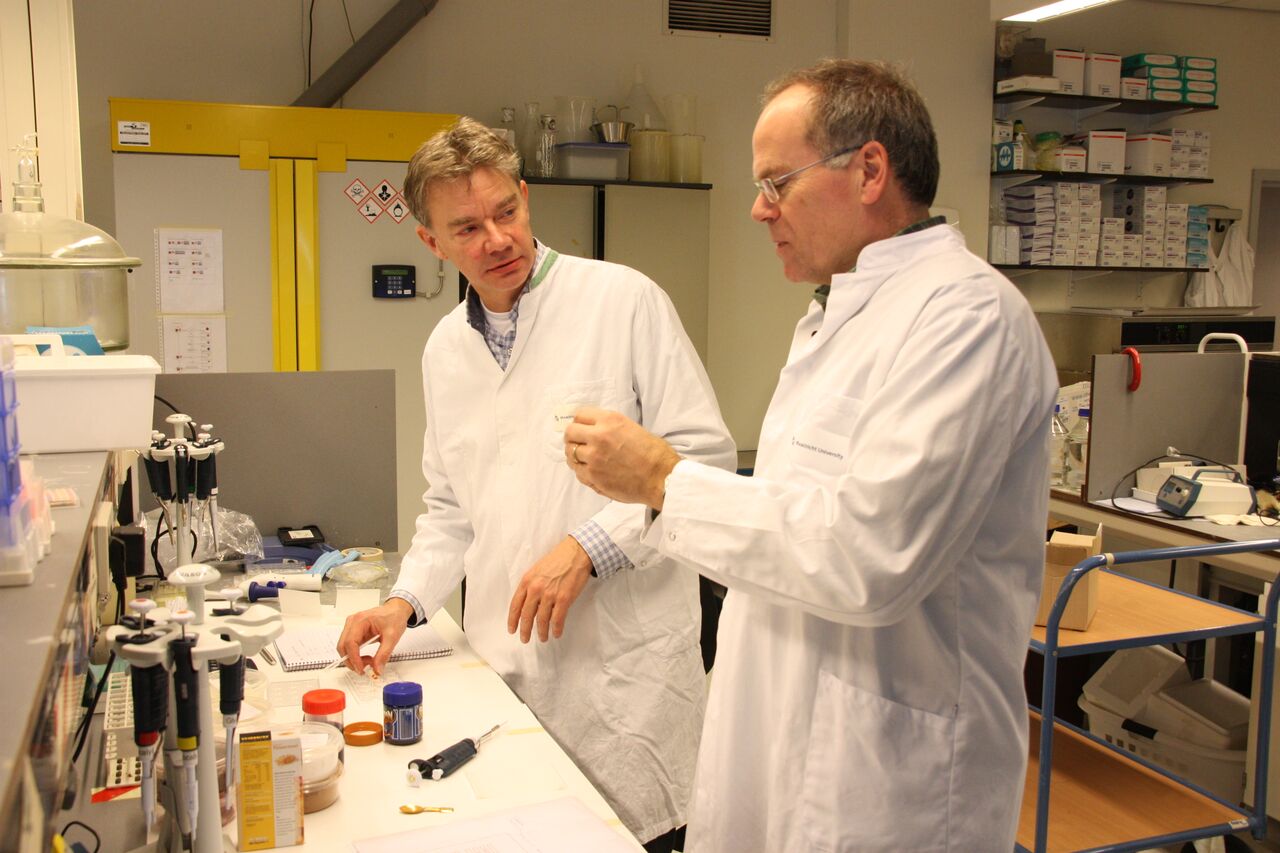
Peter Verstrate, left and Mark Post, right, in the lab at Maastricht University.
In 2010, a large family foundation reached out to New Harvest founder Jason Matheny, asking which labs to support to advance cultured meat. Jason directed the foundation to Mark. The foundation was Google co-founder Sergey Brin’s family foundation. They worked with Mark towards a huge media event where the first cultured hamburger would be tasted, supporting the costs of the research and the event.
The cultured beef burger tasting event from August 5, 2013.
In August of 2013, the first cell cultured hamburger was cooked and tasted live on air in London, England. The event was attended by 200 journalists from around the world, the academics who worked on the Dutch Cultured Meat Project, and New Harvest.
The burger was made up of around 20,000 muscle strands grown in Mark’s laboratory. It was made with a little egg powder and breadcrumbs and a few other common burger ingredients. It was tasted by Mark, food writer Josh Schonwald and nutritional researcher Hanni Rützler. The burger was cooked by Chef Richard McGeown, of Couch’s Great House Restaurant in Cornwall.
The Process
The purpose of the cultured beef hamburger was to show the world that it was scientifically possible create an edible beef burger from cultured cells. The process of creating the burger used primarily tried and tested methods of muscle cell tissue culture.
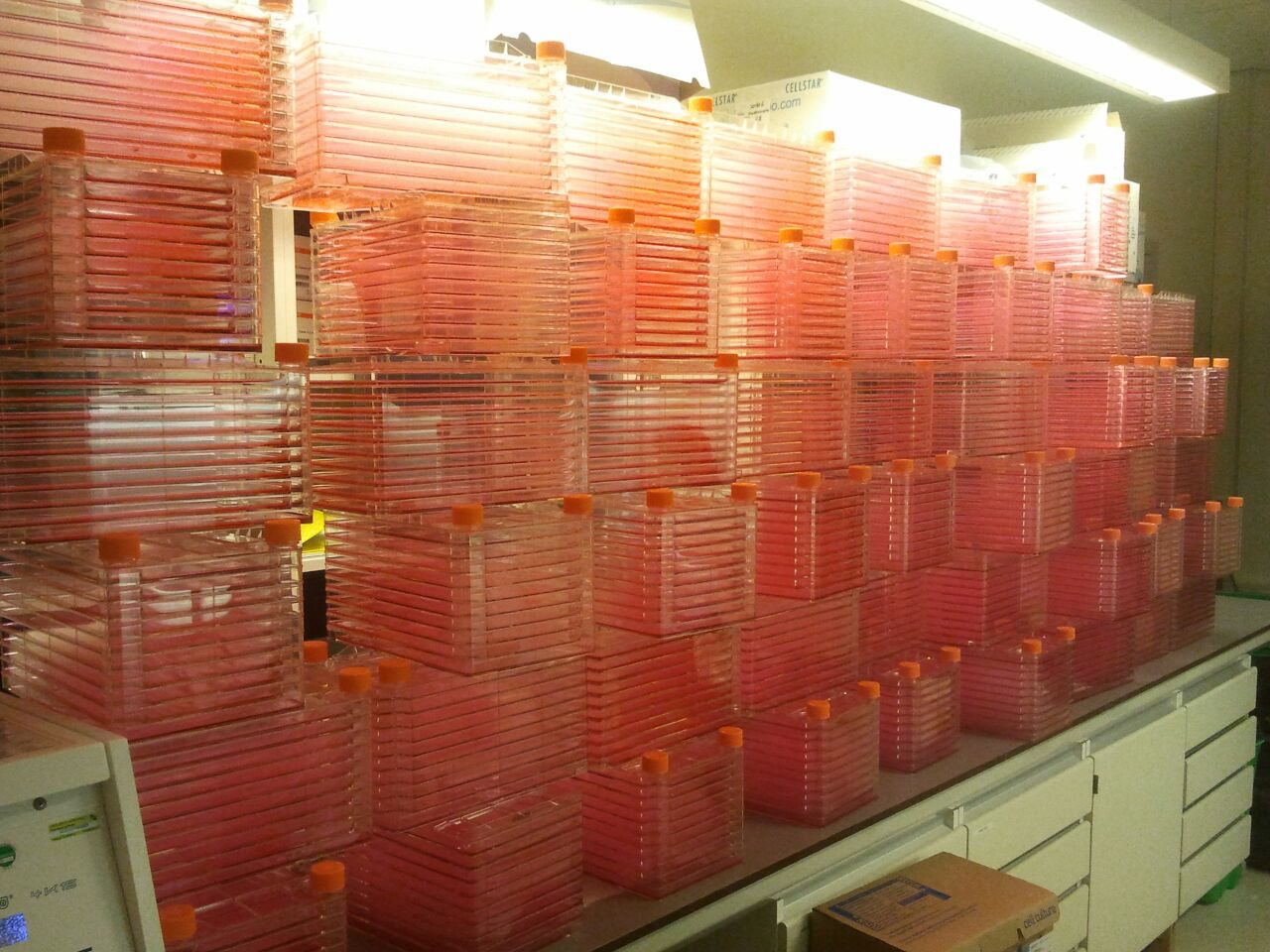
A photo from Dr. Post’s lab by Daan Luining. 10-layer tissue culture flasks used for making a piece of hamburger. Making the entire hamburger took many more culture flasks than what is shown here.
The burger cost €250,000 to produce. It cost this much because the project took place at laboratory scale. The technicians making the burger did so by producing very small strands of beef in standard tissue culture flasks, and repeating this work several thousands of times. The price of the burger was so high because it included the salaries of skilled technicians doing very time-consuming work and consuming expensive laboratory supplies. Anon Essen, Sanne Verbrugge, and Ruud Theunissen were the laboratory technicians that did the bench work to create the first cultured beef hamburger.
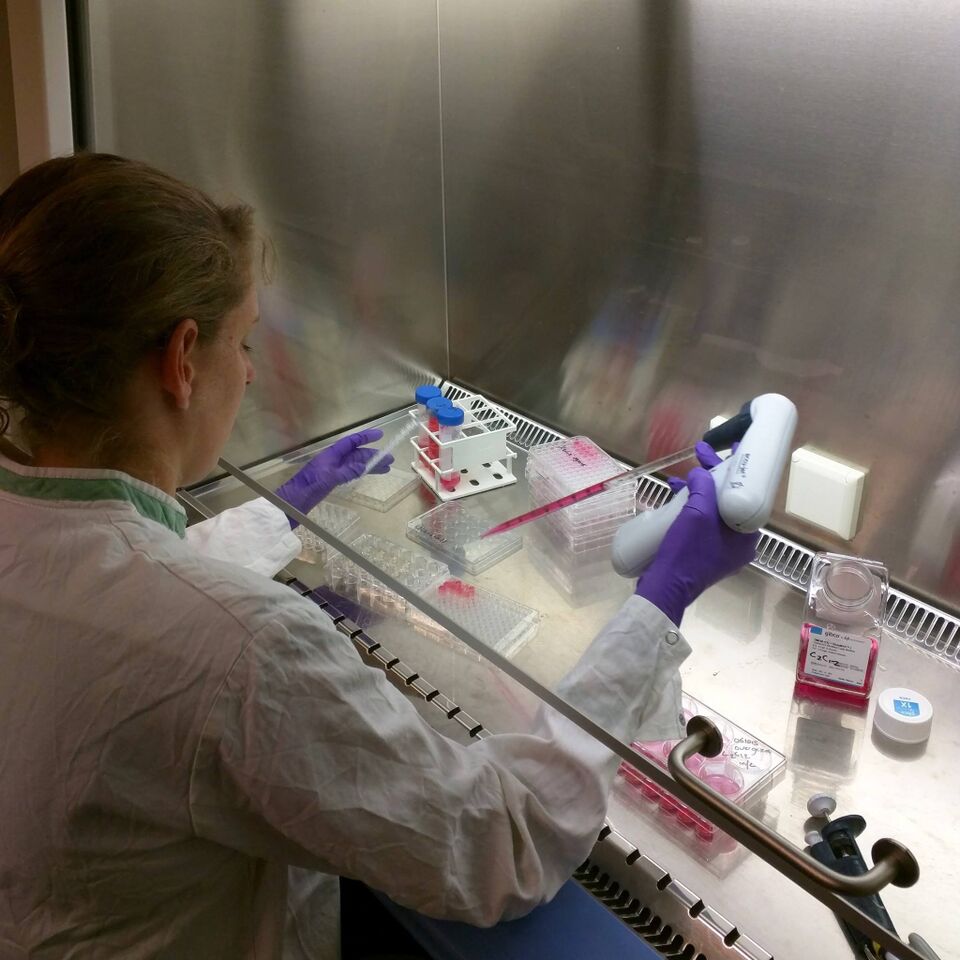
A photo from Dr. Post’s lab of a technician maintaining a muscle cell culture.
One challenge in producing the burger was how to help the muscle fibers mature. Muscle fibers mature much better with contraction. Researchers in Mark’s lab found that seeding muscle cells around a cylinder of gel allowed the cells to create a fiber in the shape of a ring, which then could contract on itself.
How Mark Post’s lab created the cultured beef burger.
A second challenge was growing a large number of muscle cells. Because muscle grows only about 0.5mm in culture, the best way to mass produce the culture is by providing a lot of surface area for muscle cells to grow on.
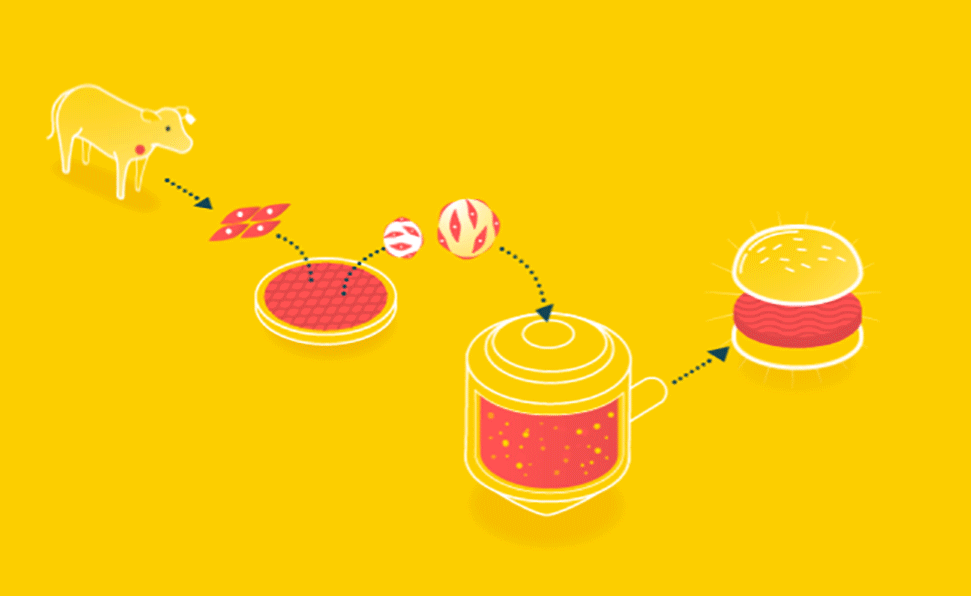
Because cells can only grow about 0.5mm thick in culture, it is easier to grow “ground” beef. Muscle cells could be grown on beads, which offer a lot of surface area, in a bioreactor, and when the muscle cells are removed, it will already have the consistency of hamburger.
Mark Post’s lab worked on some projects involving growing muscle cells on beads.
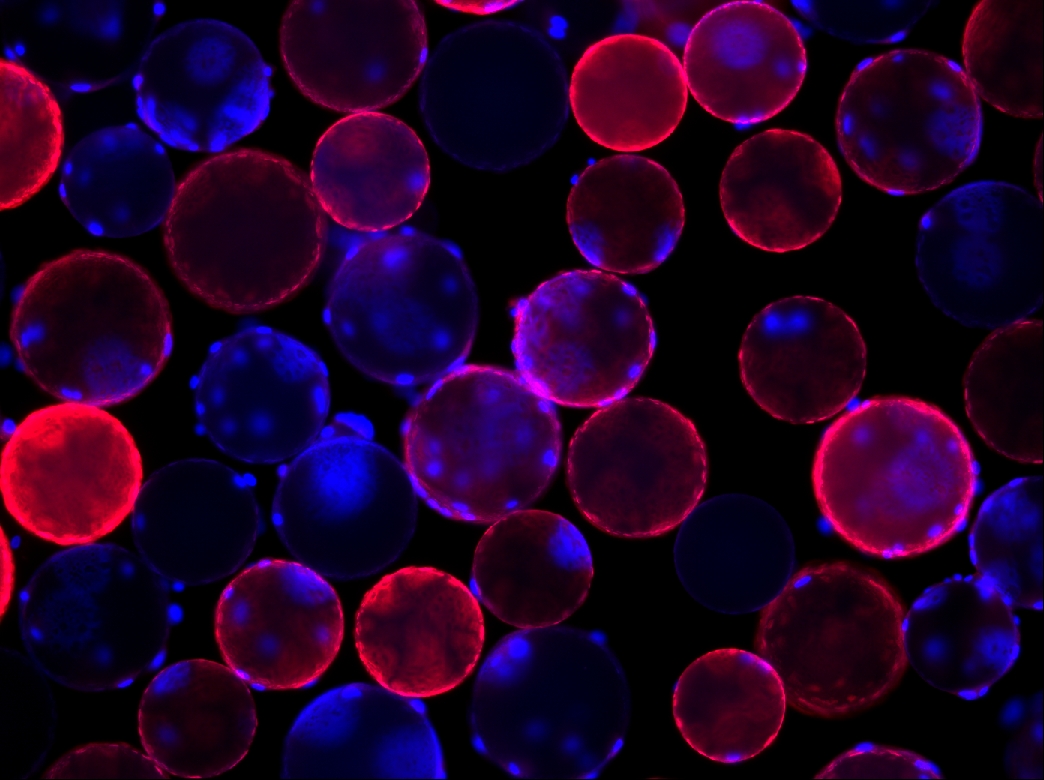
Muscle cells (nuclei stained blue with DAPI) growing on the surface of microcarrier beads (stained red with rhodamine) from Dr. Mark Post’s lab at the University of Maastricht. Muscle cells need to grow attached onto a surface. Beads offer a lot of surface area, ideal for growing a lot of cells.
Another challenge in producing the cell cultured beef burger was creating an animal-free system. The status quo for culturing tissue involves the use of fetal bovine serum, an unsustainable byproduct of the livestock industry collected from fetal cows. Like other animal products, there is a lot of variation from batch to batch, an inconsistent supply, and possibility of contamination. It is the status quo because it works very well, despite little understanding on why it works. It is also relatively inexpensive.
In the creation of the cultured beef burger, Mark’s lab experimented with animal-free media for the cells to grow in. By the end of the production of the burger, the muscle strands were grown in media with zero fetal bovine serum. In early 2015, New Harvest provided Mark’s lab with $50,000 to do more research on a completely animal-free system for growing cultured meat.
Written by Isha Datar with help from Daan Luining November 3, 2015


